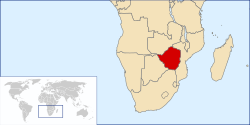Chief Justice of Southern Rhodesia
| Colony of Southern Rhodesia | ||||||||||||||||
| Self-governing British colony | ||||||||||||||||
|
||||||||||||||||
|
Anthem God Save the King (1923–1952) God Save the Queen (1952–1953; 1963–1965; 1979–1980) |
||||||||||||||||
|
Location of Southern Rhodesia in southern Africa
|
||||||||||||||||
| Capital | Salisbury | |||||||||||||||
| Languages |
English (official) Shona and Sindebele widely spoken, some Afrikaans |
|||||||||||||||
| Government | Constitutional monarchy | |||||||||||||||
| Governor | ||||||||||||||||
| • | 1923–1928 | Sir John Robert Chancellor | ||||||||||||||
| • | 1959–1969b | Sir Humphrey Gibbs | ||||||||||||||
| • | 1979–1980 | Lord Soames | ||||||||||||||
| Prime Minister | ||||||||||||||||
| • | 1923–1927 | Sir Charles Coghlan (first) | ||||||||||||||
| • | 1964–1965 | Ian Smith (last) | ||||||||||||||
| History | ||||||||||||||||
| • | BSAC administration | 1890–1923 | ||||||||||||||
| • | Annexed by Britain | 12 September 1923 | ||||||||||||||
| • | Responsible Government | 1 October 1923 | ||||||||||||||
| • | Federation | 1953–1963 | ||||||||||||||
| • | UDI | 11 November 1965 | ||||||||||||||
| • | Republic declared | 3 March 1970 | ||||||||||||||
| • | Zimbabwe Rhodesia | 1 June 1979 | ||||||||||||||
| • | Independence | 18 April 1980 | ||||||||||||||
| Area | ||||||||||||||||
| • | 1904 | 372,518 km2 (143,830 sq mi) | ||||||||||||||
| Population | ||||||||||||||||
| • | 1904 est. | 605,764 | ||||||||||||||
| Density | 2/km2 (4/sq mi) | |||||||||||||||
| Currency | Southern Rhodesian pound Rhodesian pound |
|||||||||||||||
|
||||||||||||||||
| Today part of |
|
|||||||||||||||
| a. | Position not recognised by the Rhodesian government after 2 March 1970 | |||||||||||||||
| b. | Position not recognised by Rhodesian Government after 11 November 1965 | |||||||||||||||
The Colony of Southern Rhodesia was a self-governing British Crown colony in southern Africa from 1923 to 1980, the predecessor state of modern Zimbabwe.
Following its Unilateral Declaration of Independence in 1965, the nation existed as the self-declared, unrecognised state of Rhodesia until 1979, when it reconstituted itself under indigenous African rule as Zimbabwe Rhodesia, which also failed to win overseas recognition. After a period of interim British control following the Lancaster House Agreement in December 1979, the country achieved internationally recognised independence as Zimbabwe in April 1980.
Initially, the territory was referred to as "South Zambezia", a reference to the River Zambezi, until the name "Rhodesia" came into use in 1895. This was in honour of Cecil Rhodes, the British empire-builder and key figure during the British expansion into southern Africa. In 1888 Rhodes obtained mineral rights from the most powerful local traditional leaders through treaties such as the Rudd Concession and the Moffat Treaty, which was signed by King Lobengula of the Ndebele people. "Southern" was first used in 1898 and dropped from normal usage in 1964, on the break-up of the Federation of Rhodesia and Nyasaland. "Rhodesia" then remained the name of the country until the creation of Zimbabwe Rhodesia in 1979. Legally, from the British perspective, the name Southern Rhodesia continued to be used until 18 April 1980, when the Republic of Zimbabwe was promulgated.
...
Wikipedia



